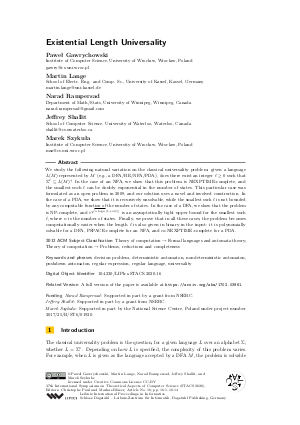Existential Length Universality
Authors Paweł Gawrychowski, Martin Lange, Narad Rampersad, Jeffrey Shallit, Marek Szykuła
-
Part of:
Volume:
37th International Symposium on Theoretical Aspects of Computer Science (STACS 2020)
Part of: Series: Leibniz International Proceedings in Informatics (LIPIcs)
Part of: Conference: Symposium on Theoretical Aspects of Computer Science (STACS) - License:
 Creative Commons Attribution 3.0 Unported license
Creative Commons Attribution 3.0 Unported license
- Publication Date: 2020-03-04
File

PDF
LIPIcs.STACS.2020.16.pdf
- Filesize: 0.58 MB
- 14 pages
Document Identifiers
Related Versions
-
A full version of the paper is available at https://arxiv.org/abs/1702.03961.
Subject Classification
ACM Subject Classification
- Theory of computation → Problems, reductions and completeness
- Theory of computation → Formal languages and automata theory
Keywords
- decision problem
- deterministic automaton
- nondeterministic automaton
- pushdown automaton
- regular expression
- regular language
- universality
Metrics
- Access Statistics
-
Total Accesses (updated on a weekly basis)
0PDF Downloads0Metadata Views
Abstract
We study the following natural variation on the classical universality problem: given a language L(M) represented by M (e.g., a DFA/RE/NFA/PDA), does there exist an integer ? ≥ 0 such that Σ^? ⊆ L(M)? In the case of an NFA, we show that this problem is NEXPTIME-complete, and the smallest such ? can be doubly exponential in the number of states. This particular case was formulated as an open problem in 2009, and our solution uses a novel and involved construction. In the case of a PDA, we show that it is recursively unsolvable, while the smallest such ? is not bounded by any computable function of the number of states. In the case of a DFA, we show that the problem is NP-complete, and e^{√{n log n} (1+o(1))} is an asymptotically tight upper bound for the smallest such ?, where n is the number of states. Finally, we prove that in all these cases, the problem becomes computationally easier when the length ? is also given in binary in the input: it is polynomially solvable for a DFA, PSPACE-complete for an NFA, and co-NEXPTIME-complete for a PDA.
Cite As Get BibTex
Paweł Gawrychowski, Martin Lange, Narad Rampersad, Jeffrey Shallit, and Marek Szykuła. Existential Length Universality. In 37th International Symposium on Theoretical Aspects of Computer Science (STACS 2020). Leibniz International Proceedings in Informatics (LIPIcs), Volume 154, pp. 16:1-16:14, Schloss Dagstuhl – Leibniz-Zentrum für Informatik (2020)
https://doi.org/10.4230/LIPIcs.STACS.2020.16
BibTex
@InProceedings{gawrychowski_et_al:LIPIcs.STACS.2020.16,
author = {Gawrychowski, Pawe{\l} and Lange, Martin and Rampersad, Narad and Shallit, Jeffrey and Szyku{\l}a, Marek},
title = {{Existential Length Universality}},
booktitle = {37th International Symposium on Theoretical Aspects of Computer Science (STACS 2020)},
pages = {16:1--16:14},
series = {Leibniz International Proceedings in Informatics (LIPIcs)},
ISBN = {978-3-95977-140-5},
ISSN = {1868-8969},
year = {2020},
volume = {154},
editor = {Paul, Christophe and Bl\"{a}ser, Markus},
publisher = {Schloss Dagstuhl -- Leibniz-Zentrum f{\"u}r Informatik},
address = {Dagstuhl, Germany},
URL = {https://drops.dagstuhl.de/entities/document/10.4230/LIPIcs.STACS.2020.16},
URN = {urn:nbn:de:0030-drops-118770},
doi = {10.4230/LIPIcs.STACS.2020.16},
annote = {Keywords: decision problem, deterministic automaton, nondeterministic automaton, pushdown automaton, regular expression, regular language, universality}
}
Author Details
Funding
- Rampersad, Narad: Supported in part by a grant from NSERC.
- Shallit, Jeffrey: Supported in part by a grant from NSERC.
- Szykuła, Marek: Supported in part by the National Science Centre, Poland under project number 2017/25/B/ST6/01920.
References
-
A. V. Aho and J. E. Hopcroft. The Design and Analysis of Computer Algorithms. Addison-Wesley Longman Publishing Co., Inc., 1st edition, 1974.

-
R. Alur and P. Madhusudan. Visibly pushdown languages. In Proc. of the 36th Annual ACM Symposium on Theory of Computing, STOC 2004, pages 202-211. ACM, 2004.

-
N. Bertrand, P. Bouyer, T. Brihaye, and A. Stainer. Emptiness and universality problems in timed automata with positive frequency. In Proceedings of the 38th International Conference on Automata, Languages and Programming - Volume Part II, ICALP 2011, pages 246-257. Springer, 2011.

-
L. Doyen and J.-F. Raskin. Games with imperfect information: theory and algorithms. In Krzysztof R. Apt and Erich Grädel, editors, Lectures in Game Theory for Computer Scientists, pages 185-212. Cambridge University Press, 2011.

-
L. Fleischer and M. Kufleitner. Green’s relations in finite transformation semigroups. In Pascal Weil, editor, CSR, pages 112-125. Springer, 2017.

-
O. Friedmann and M. Lange. Ramsey-Based Analysis of Parity Automata. In TACAS, volume 7214 of LNCS, pages 64-78. Springer, 2012.

-
E. Grädel. Dominoes and the Complexity of Subclasses of Logical Theories. Annals of Pure and Applied Logic, 43(1):1-30, 1989.

-
C. Haase. Subclasses of Presburger Arithmetic and the Weak EXP Hierarchy. In CSL-LICS, CSL-LICS, pages 47:1-47:10. ACM, 2014.

-
J. E. Hopcroft and J. D. Ullman. Introduction to Automata Theory, Languages, and Computation. Addison-Wesley, 1979.

-
N. D. Jones. Space-bounded reducibility among combinatorial problems. Journal of Computer and System Sciences, 11(1):68-85, 1975.

-
M. Krötzsch, T. Masopust, and M. Thomazo. On the complexity of universality for partially ordered NFAs. In MFCS, pages 61:1-61:14, 2016.

-
J. Mazoyer. A six-state minimal time solution to the firing squad synchronization problem. Theoretical Computer Science, 50(2):183-238, 1987.

-
F. R. Moore and G. G Langdon. A generalized firing squad problem. Information and Control, 12(3):212-220, 1968.

-
N. Rampersad, J. Shallit, and Z. Xu. The computational complexity of universality problems for prefixes, suffixes, factors, and subwords of regular languages. Fundamenta Informaticae, 116(1-4):223-236, 2012.

- J. Shallit. Open problems in automata theory: an idiosyncratic view, LMS Keynote Address in Discrete Mathematics, BCTCS 2014, April 10 2014, Loughborough, England. URL: https://cs.uwaterloo.ca/~shallit/Talks/bc4.pdf.
-
P. van Emde Boas. The convenience of tilings. In Complexity, Logic, and Recursion Theory, pages 331-363. Marcel Dekker Inc., 1997.

-
M. Y. Vardi and P. Wolper. Reasoning About Infinite Computations. Information and Computation, 115(1):1-37, 1994.

- G. Zetzsche. The complexity of downward closure comparisons. https://arxiv.org/abs/1605.03149, 2016. URL: https://arxiv.org/abs/1605.03149.
